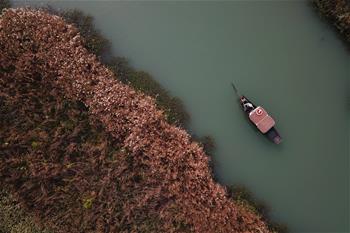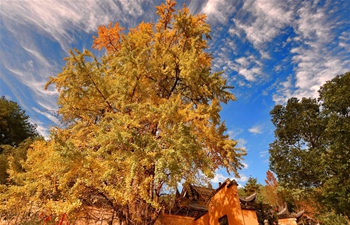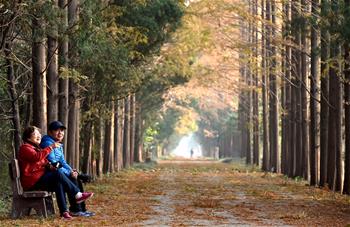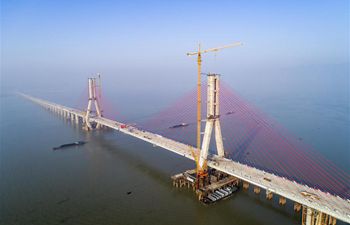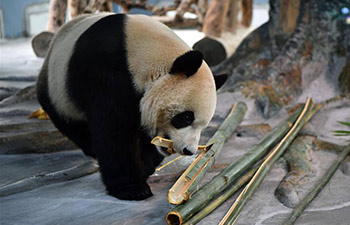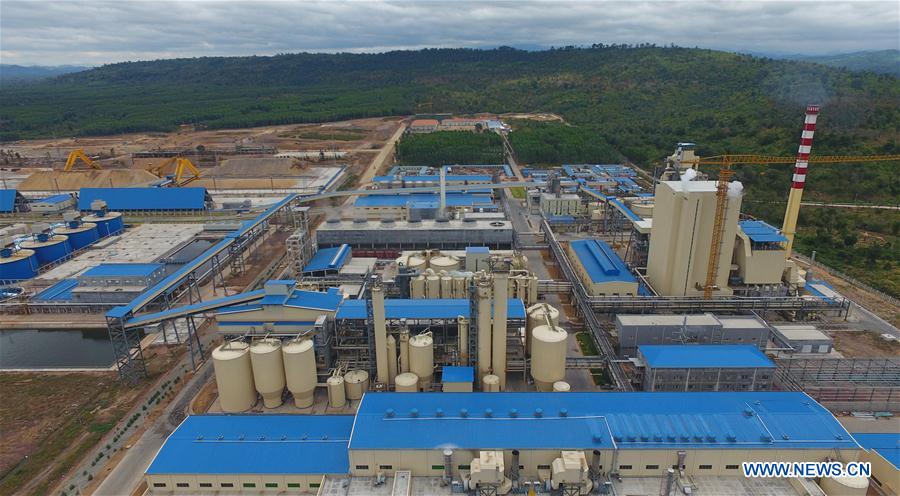
Aerial photo taken on Nov. 23, 2018 shows the first modern pulp mill of Sun Paper Holdings Laos Co., Ltd. in Xepon, Savannakhet Province, some 410 km east of Lao capital Vientiane. The first modern pulp mill in Laos, invested in by Sun Paper Laos, is bringing prosperity and more employment opportunities to the central lao village and local villagers. Sun Paper Group signed an investment agreement on "Forest-Pulp-Paper Integration" with the Lao government in November, 2009. The company has invested a total of 432 million U.S. dollars and started trial production in the central Laos' hills in May this year. The Sun Paper factory uses the bark, wood chips and waste liquid to generate electricity. The power not only fulfill the factory's needs, but can also supply the local power grid. (Xinhua/Liu Ailun)
by Zhang Jianhua, Wang Shan, Liu Ailun
XEPON, Laos, Nov. 28 (Xinhua) -- The first modern pulp mill in Laos, invested in by a Chinese enterprise, is bringing prosperity and more employment opportunities to the central lao village and local villagers.
Sun Paper Holdings Laos Co., Ltd. (Sun Paper Laos), established in May, 2008, is a wholly-owned company of Shandong Sun Paper Group, one of China's top 500 enterprises. Sun Paper Group signed an investment agreement on "Forest-Pulp-Paper Integration" with the Lao government in November, 2009.
Since January, 2017, the hardwood pulp production line with an annual production of 300,000 tons was started in Xepon, Savannakhet Province, some 410 km east of Lao capital Vientiane. The company has invested a total of 432 million U.S. dollars and started trial production in the central Laos' hills in May this year.
Entering Sun Paper's Lao factory in a valley, visitors can find the road neat and tidy, with flowers and trees planted along the roads. The workshops presented in the production process, and the raw materials such as logs and wood chips piled up in order.
Processing steps like washing, screening, bleaching, drying, slicing and packing are all carried out in tanks, pipes and steel structures. There are not many workers on site, but dozens of technicians can be seen in the comfortable control room, busy in closely monitoring the equipment status and production process.
According to Chen Wenjun, general manager of Sun Paper Holdings Laos, the production line is equipped with the world's top equipment. The cutting-edge equipment and technology fill the gap in the Lao pulping industry.
"In the past, when this factory was not built, it was an vast wasteland dotted with some trees," Khamphone Ketmaly, head of Naluang Village next to the factory, said.
"The company started construction last year and I also came to witness the ceremony. The construction of the Sun Paper factory has made this land richer and bustling, and the change is quite big. For example, the Chinese company has greatly upgraded the road, thus to improve the transportation, and the factory has shown us many things we have never seen before," Khamphone told Xinhua in late November this year.
The Sun Paper factory uses the bark, wood chips and waste liquid to generate electricity. The power not only fulfill the factory's needs, but can also supply the local power grid.
The factory sells six million kilowatt-hours monthly to local grid. "There is some profit made from power generation, but the construction cost of the power station is much higher. Our initial thinking is of environmental protection, waste utilization, and emission reduction," Chen Wenjun told Xinhua.
Meanwhile, due to environmental considerations, the factory's general drainage outlets have become the focus of visitors: the waste water discharge port is very rural, used to raise a group of ducks and many fish, even including a few delicate goldfish.
In addition to ensuring all emission data meet the requirements, raising fish and ducks can make the nearby people and visitors visually understand the company's high standards in environmental protection.
"The company also cares education of the surrounding villages. The company investigates and collects the information of each village, and then provides stationery, teaching and learning supplies according to the actual situation. It also built schools for the villages without schools. As long as there are needs, the village will turn to the company for support and help," the head of the village Khamphone said, adding that there are now more than 400 Lao employees working in the company.
Poverty alleviation is an arduous task confronting the Lao government. Some of the villagers around the Sun Paper factory in central Laos have embarked on the road to prosperity.
"My family is near the factory. After the company came in, the company interacted with the surrounding villages and invited the villagers to join the company's projects," Phonethong Xayyasouk, a 65-year-old local man said.
"My family has planted 25,000 trees in three years and earned eight million kip (about 933 U.S. dollars) last year. This year, I mobilized villagers to plant 250,000 trees and I planted 13,000 among them," he said.
Phonethong introduced that if the trees reach the set standards, the Sun Paper will pay the co-planter 1000 kip (about 0.12 U.S. dollars) for each tree annually and the company will give 10,000 kip to the co-planter (about 1.2 U.S. dollars) when the trees are harvested.
"Now my family has changed a lot and has a relatively high income. In general, after the company came in, it has increased the employment opportunities of the villagers, especially for the young people. We can work in the company and we can also plant trees to make money," Phonethong said.
The smile and laughter of the Lao villager during the interview showed his satisfaction and revealed his confidence in the investment and construction of the Chinese company.







